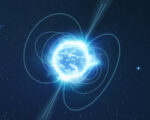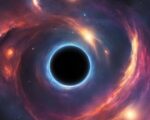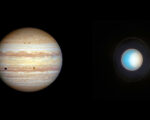Breakthrough Research Aims to Solve Stephen Hawking’s Black Hole Radiation Paradox

New Study Proposes Frozen Stars as a Solution to Black Hole Paradoxes
The Frozen Star Concept
A groundbreaking theory challenges the traditional understanding of black holes, proposing that they may actually be “frozen stars.” Unlike black holes, frozen stars do not feature singularities or event horizons, which are typically associated with the inescapable pull of gravity. This theory is led by physicist Ramy Brustein of Ben-Gurion University, who suggests that if these frozen stars exist, it would require a rethinking of some aspects of Einstein’s general relativity. Instead of collapsing into a singular point, frozen stars retain a structure that prevents the issues tied to infinite density, potentially resolving many of the paradoxes that currently puzzle physicists.
Implications for Physics
One of the most significant impacts of the frozen star model is its potential to solve the information loss paradox, which has long been a challenge in black hole physics. The information loss paradox suggests that all information about matter that falls into a black hole is lost forever, conflicting with the laws of quantum mechanics. Frozen stars, by not collapsing into singularities, avoid this issue, providing a framework where information might not be lost. This could be a crucial step in reconciling the differences between general relativity and quantum mechanics.
Gravitational Waves as a Test
The frozen star theory could be tested through gravitational wave data, especially from cosmic events like mergers between what were thought to be black holes. The waves produced during these events might carry signatures unique to frozen stars, allowing scientists to differentiate them from traditional black holes. Observatories like LIGO and Virgo, which have detected gravitational waves from black hole collisions, could provide key data to either support or refute the frozen star model.

Rethinking Cosmic Phenomena
Frozen stars may also challenge the understanding of other cosmic phenomena, particularly neutron stars. While both neutron stars and frozen stars are dense remnants of stellar collapse, frozen stars could possess unique internal structures that set them apart. Brustein’s theory encourages scientists to investigate how these objects might manifest observationally, potentially reshaping the study of stellar remnants and the lifecycle of massive stars.
Observational Challenges
Despite the promise of the frozen star model, there are still many unknowns. For instance, scientists need to better understand how these objects behave internally and how to conclusively distinguish them from black holes and neutron stars. Current astrophysical tools may not be sensitive enough to make this distinction easily, but upcoming advancements in observational technology could provide new opportunities to explore this theory.
A Potential Paradigm Shift
If validated, the frozen star concept could revolutionize the understanding of black holes and spacetime. Brustein and his team believe that further observational evidence, particularly through gravitational wave research, could finally unlock the mysteries surrounding black holes and offer a new way of looking at the universe. This theory has the potential to reshape both theoretical and experimental physics, providing a much-needed solution to some of the biggest questions in astrophysics.

















